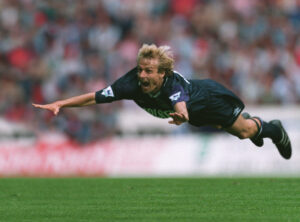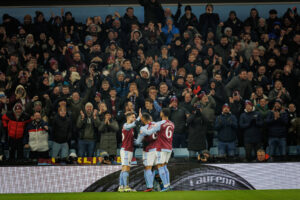Welcome to the new series of articles from Last Word on Football. This series looks at the grounds that are sadly no longer with us. Grounds that are famous not only in their particular country but also around the world. Grounds that will always have a special place in the hearts of a particular team’s supporters and fans of football alike. Many will have loved them, some may have hated them; however, they could never be forgotten.
White Hart Lane was a fantastic stadium for its atmosphere, its closeness to the pitch and for the memories that were forged in the 119 years in which it stood. It shall always be part of Tottenham Hotspur’s identity. This article will attempt to bring together the many strands of memory and history, where, in truth, a whole series of articles would be needed to fully capture the grandeur of this stadium’s history.
Never to Be Forgotten Football Grounds: White Hart Lane
Origins
The story of White Hart Lane began on the grounds of a disused nursery. This land was rented from the brewery, with mobile stands brought over from the previous ground, which had become too overcrowded.
Opening
Some sources have it that the very first match at White Hart Lane was the friendly against Notts County. However, from the official club website, there were some unofficial matches before then; there were about four trial matches prior to that friendly, which involved the Whites versus the Stripes.
The first official match was a 4-1 home victory in a friendly versus Notts County. Tommy McCairns of Notts County was the first-ever player to score at the ground. But, Tom Pratt and David Copeland helped Spurs to a fantastic comeback.
Tottenham beat Queens Park Rangers 1-0 in the first competitive match held at the stadium; Tom Smith notched the first-ever competitive goal scored at the Lane.
Developments and Improvements
Archibald Leitch was the key architect behind some major improvements to the stadium. Between 1909 and 1934, the capacity reached 80,000.
This capacity dropped to 50,000 in 1979. Seating had begun to replace the standing areas. However, the Shelf remained, with all its raucous standing atmosphere.
The Shelf
The East Stand was rebuilt in 1934. There were two main tiers, but the lower section was split into two. Thus, the middle section became the Shelf. In total there was enough room for 18,700 standing supporters. This would be a hive of cheering, chants and song for many years.
Shelf Side was refurbished in 1988. The upper section was replaced by executive boxes. This is perhaps one of the first registrations of modern-day commercialism at the club. Nevertheless, the upper East Stand, and towards the Park Lane End, would still live on as The Shelf.
War-Time White Hart Lane
Two world wars affected the stadium. During the Great War, the Ministry of War took control of the stadium. The East Stand became a factory for gas marks, guns, and protective equipment. Spurs consequently, had to use both Arsenal’s Highbury and Clapton Orient’s Homerton as their grounds.
In the Second World War, White Hart Lane returned the favour to Arsenal. The rival club’s ground was used as an Air Raid Precautions Centre.
Story of the Cockerel
White Hart Lane’s famous cockerel was first cast in 1909. Ex-player William James Scott was the maker. In 1989 this original cast was taken down and moved to the executive suites. It now resides at Lilywhite House. There is a replica of this splendid cockerel atop the new stadium.
Nobody Left Standing
Ernest Atherden was the architect who devised a new West Stand. This was part of a new drive to update White Hart Lane’s facilities. This included a further 72 executive boxes.
The Taylor Report of 1990 called for all-seater stadiums and this spelt the end for standing areas inside White Hart Lane. Between 1994 and 1998 there was a series of developments. The capacity was reduced to about 36,000.
Three Classic Matches at the Lane
Tottenham Hotspur Win Inaugural UEFA Cup
Following a 2-1 win against Wolverhampton Wanderers in the first leg, the club held on at The Lane to a 1-1 draw to lift the first UEFA Cup. Alan Mullery scored first for Spurs in that glorious moment in May 1972.
Martin Chivers spoke of his confidence at the club returning to White Hart Lane for the second leg.
“I thought, ‘We have a very good chance now because Tottenham are so strong at home, especially in European games.’ European games at Tottenham, the atmosphere out there was just electric. And we wore the all-white strip, which we always made a point of wearing in European games. And with that crowd behind us, I think it was the most exciting football we played in the early 70s. I think when you win 2-1 away you feel you have a very good chance. And once Alan Mullery popped up with that header and we had a two-goal cushion, we felt we had a great chance that we were going to win this cup.”
Tony Parks the Penalty Shootout Hero as Spurs Lift Another Uefa Cup
In May 1984, Spurs won another UEFA Cup at home at the Lane. This time the Lilywhites went 1-0 down. Graham Roberts found the ball at his feet following a ball into the box and eventually adjusted those feet to slot home the equaliser.
So, it all came down to penalties at White Hart Lane. A pivotal moment came after a Tony Parks save, with Danny Thomas stepping up. Thomas needed to score to capture the UEFA cup. But, the full-back’s penalty could not beat Jacky Munaron. Groans rang out across the ground. However, moments later, the Spurs faithful were singing Danny Thomas’ name.
In the end, Thomas’ miss only served to give Tony Parks even more glory. Parks dived to his right-hand post, saving Arnór Guðjohnsen’s attempt. He then wheeled away, two arms aloft to the roar of the crowd.
Tottenham Turn the Tide
It is hard to follow up the previous two matches at the Lane. This is chiefly because the club have failed to win anything for such a long time. But, equally, cup finals aren’t held in the same way. Instead, one of the modern classic encounters was New Years Day in 2015.
Chelsea took the lead, and it looked to be business as usual. However, Harry Kane pulled out a fantastic low driven equaliser. Nacer Chadli was an influence in this tie. His shot cannoned off the post, only for Danny Rose to drive in the rebound for Spurs to take the lead.
Kane won a penalty from a clumsy Gary Cahill challenge. Up steps Andros Townsend, who gives Spurs a 3-1 lead before half time.
Harry Kane then found himself in the box again, executing a lovely turn before a sumptuous finish into the bottom right corner. There was no way back now, surely? Federico Fazio tried his best as he allowed Chelsea to counter-attack, bringing it back to 4-2. However, Chadli drove at Chelsea and smashed a shot through John Terry‘s legs for 5-2. Spurs’ inveterate enemy would get the last goal, but this was only a consolation in 5-3 thriller.
This match didn’t win Spurs a trophy. But, it was the start of a turning tide that has seen the club begin to reach towards its previous heights.
Decline
The decline of the Lane came with the need for a new stadium on a much bigger scale. From a 36,000 capacity, Spurs upgraded to the Tottenham Hotspur Stadium which can seat at least 62,000 people. The biggest clubs in European football have stadia with similar capacities and modern facilities. Thus, the club needed to ensure it had the right foundations to progress. Daniel Levy cites that:
“When I took over the club, Tottenham was not a club that was a regular European challenger,” “Clearly, we are now and my dream is obviously to win. We want to win, and winning is both on the pitch and off the pitch, so we are going to keep going until we get both right.”
But, football aside, there were wider-reaching causes for the end of White Hart Lane and the need for new facilities; Executive director Donna Cullen, as reported by the Independent, “stated that the 2011 Tottenham riots were the “trigger’ to finally act on long-term plans for the stadium, and invest in the area.”
Farewell
One Last Match at the Lane
White Hart Lane didn’t vanish immediately. There was one last glorious season where Spurs were unbeaten at home. Some of it was played in front of a reduced crowd, with a corner of the stadium exposed to allow for the start of the new ground’s construction. At the end of the season, this culminated in a final farewell match at the Lane. Victor Wanyama planted a thumping header past Manchester United’s David de Gea. It was a fantastic cross by Ben Davies.
The second goal of the match, the final goal at White Hart Lane, was scored by none other than Harry Kane. Christian Eriksen whipped in a ferocious ball, with Kane getting enough on it to send it past de Gea.
After-Party
When the final whistle sounded, the fans streamed onto the pitch. This was truly an emotional affair. After the fans had been coaxed back to their seats, a ceremony followed. A whole host of Spurs ex-players emerged from the tunnel; Osvaldo Ardiles, Cliff Jones, Justin Edinburgh, Pat Jennings, Dimitar Berbatov were just a small sample of the host of illustrious names. They provoked a whole plethora of memories amongst the Spurs faithful old and young.
There was music from the local community; Spurs chants were set to a choir and then a rousing performance from Wynne Evans followed.
In one of the closing moments, there was one particular song that resounded within the old ground. “We are Tottenham, Super Tottenham, from the Lane.” When White Hart Lane was pulled down, the club lost its iconic emblem. The new stadium will never be the Lane. It was a ground full of memories and emotions; it was a ground that was built for the supporters first of all and they will fondly remember it for years to come.
Main Photo






